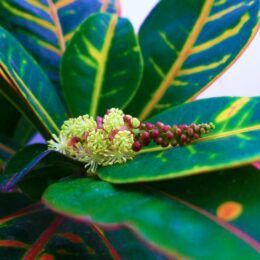An easy-to-care-for plant, croton, whose scientific name is codiaeum variegatum, is an evergreen shrub. It is predominantly found in Southeast Asia.
Types of croton plants
The different types of croton plant include
Banana croton plant

Source: Pinterest
The Banana Croton are oddly shaped and has green leaves with yellow coloured veins.
Rushfoil croton plant

Source: Pinterest
Michaux’s croton or Croton michauxii is commonly known as Rushfoil croton.
Gold dust croton plant

Source: Pinterest
This is a very bright and beautiful croton that looks as if gold dust has been added on the bright green leaves.
Mrs Iceton croton plant

Source: Pinterest
Mrs Iceton croton plant has beautiful long and narrow leaves in colours including yellow, pink, bright green, red, orange and burgundy.
Oakleaf croton plant

Source: Pinterest
A difficult to grow and be healthy plant, this needs atleast 4 hours of direct sun. A single plant has leaves which include green, pink, red, yellow and orange.
Petra croton plant

Source: Pinterest
Brighter the sun, you can see rainbow shades in this plant that requires medium maintenance.
Zanizar croton plant

Source: Pinterest
This has leathery leaves in green, yellow, pink and orange and has thin shoestring size leaves.
Croton Mammy

Source: Pinterest
Croton Mammy is a common name for the Codiaeum variegatum and is used specially for a variety of Croton that has green and yellow variegated leaves.
Garden croton
Garden croton is referred to any variety of croton that is grown in gardens. Outdoors, a croton plant grows to around six to eight ft and if the croton plant is kept in a pot, it will grow a little shorter. The average age of a croton plant is two to four years.
Croton plant indoor
With leathery and thick leaves that grow in different colours, sizes and shapes, croton plants are a welcome indoor décor plant in most Indian houses. While green croton plants are common, you also have croton plants in colours including splotches of yellow, orange and scarlet. The older the plant becomes, the darker its leaves become. The splash of colour that they bring along with them adds life to the home décor and based on the colour of the croton plant, they may blend with your walls too.
As the croton plant seed looks like a tick, it got its name ‘croton’ which means a ‘tick’ in Greek.
See also: Lucky plants for home that bring money and good luck
Croton flower
Looking like tiny stars, croton flowers hang from the branches of the croton plant. There are male and female croton flowers. While the male flower are white and appear like stars, the female flowers are yellow, have np petals and hence look like balls. If the growth conditions are favourable, then crotons can flower both indoors and outdoors. The favourable flowering season is summer and spring.

Source: Pinterest
What are the benefits of a croton plant?
- While croton plants have safety concerns, industries use them to make medicines.
- These plants help purify the air quality in the house.
- Colourful croton pants also have a great impact on one’s mental health and spread positivity in the house.
How to plant croton plants at home?
- For planting a croton plant, take a pot and ensure that there are small holes at the bottom of the pot for the water to drain.
- Place the croton plant in such a way that there is some distance between the roots and the base of the pot.
- Next, fill the pot with mud and manure. Water it diligently. Ensure you keep the croton plant where you get a lot of light, else the colours on the leaf won’t develop properly.
- You can also propagate a croton plant by its cutting. Place the cutting of the stem with a leaf in a pot, such that it is not too deep inside the pot. Also, keep the soil moist and not watery. Alternatively, you can propagate croton plant in water too instead of soil.
- Pruning the croton plant is not necessarily needed but you can remove the dried leaves once they fall, for better growth of the croton plant.
See also: How to grow and take care of Duranta Erecta
Do croton plants need a lot of sunlight?
As the beauty of the croton plant is the colour on the leaves, they cannot grow as desired if there is not enough sunlight. However, the sunlight should not be harsh.
How often do you water a croton plant?
- The croton plant is a humidity-loving plant and so it has to be watered frequently.
- However, do not make the soil soggy. This will lead to the roots decaying.
- Water the croton plant whenever the top soil becomes dry.
Croton plant placement according to Feng Shui
- According to Feng Shui, the croton plant, if cared for properly and kept in the east or the south-east part of the house, will channelise good energy in the house.
- The croton plant symbolises change owing to the colourful leaves that develop in the plant while growing.
See also: 10 beneficial Feng Shui plants for your home
Croton plant price
Croton plant starts from Rs 50 and goes anywhere till Rs 1000 and more depending on the quality, type, the placement of the plant, plant with flower, plant combined with planter etc.
FAQs
When to water a croton plant?
You can water your croton plant when you notice that the top soil in the pot is dry.
What is the most suitable direction as per Feng Shui for the croton plant?
The most suitable direction as per Vastu for croton plant is the east or the south-east.
| Got any questions or point of view on our article? We would love to hear from you.Write to our Editor-in-Chief Jhumur Ghosh at [email protected] |

With 16+ years of experience in various sectors, of which more than ten years in real estate, Anuradha Ramamirtham excels in tracking property trends and simplifying housing-related topics such as Rera, housing lottery, etc. Her diverse background includes roles at Times Property, Tech Target India, Indiantelevision.com and ITNation. Anuradha holds a PG Diploma degree in Journalism from KC College and has done BSc (IT) from SIES. In her leisure time, she enjoys singing and travelling.
Email: [email protected]











